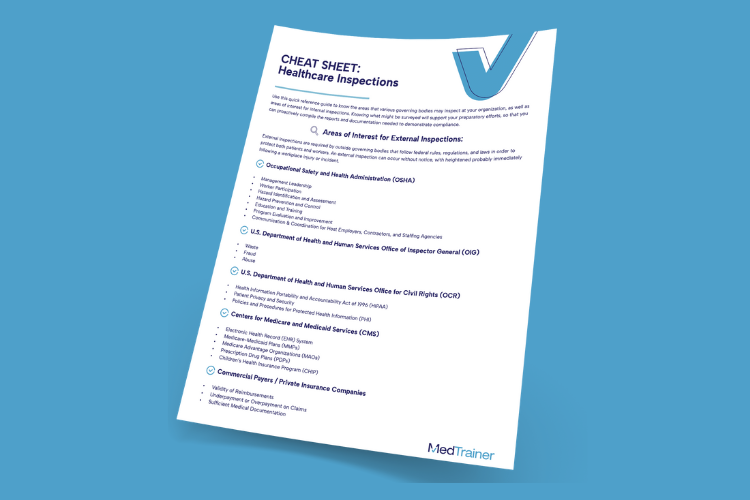Compliance with regulatory requirements is not just a necessity for healthcare providers; it’s a critical component of providing safe and ethical care to patients. Healthcare organizations therefore face myriad complex regulations. Ensuring compliance can be a daunting task, but healthcare compliance software is available to simplify the process and help organizations meet their regulatory obligations with ease.
What Is Healthcare Compliance Software?
Healthcare compliance software is a powerful tool designed to help healthcare organizations navigate the web of regulations that govern the industry. It provides a platform that facilitates the management of various compliance requirements, streamlines processes, and equips staff members with what they need to meet regulatory standards. From training and incident reporting to document management and credentialing, healthcare compliance software offers an integrated solution to tackle the complexities of compliance.
How Healthcare Compliance Software Helps You Meet Regulatory Requirements
Healthcare compliance software can help you meet your regulatory requirements with ease. Here’s how:
- HIPAA compliance: Ensuring the privacy and security of patient information is a top priority. Healthcare compliance software offers specialized modules that focus on HIPAA compliance management. From training staff on HIPAA regulations to managing breach notifications and audits, this software helps organizations maintain the confidentiality of patient data.
- OSHA compliance: Occupational safety is crucial in healthcare settings. Healthcare compliance software provides tools to navigate OSHA requirements, prepare for inspections, and create a safe environment for both employees and patients.
- OIG compliance: Staying compliant with the Office of Inspector General (OIG) is essential to prevent fraud and abuse. Healthcare compliance software assists in preparing for OIG inspections, managing compliance programs, building customized reports, analysis, and addressing potential risks.
- Streamlines the healthcare accreditation process: Healthcare compliance software can dramatically simplify the accreditation process. From preparing for surveys to documenting compliance initiatives, the software supports healthcare organizations in meeting the standards set by accrediting bodies.

Here's the cheat sheet you need to master regulatory inspections.
Features To Look for in Healthcare Compliance Software
When looking for healthcare compliance software, the options may seem endless. However, identifying essential features that align with your organizational needs can simplify your decision-making process. Here are the critical features to consider:
Employee Training:
- Integrated learning management system (LMS): An LMS should be more than just a platform for training delivery. It should be equipped with robust tracking capabilities, providing real-time insights into course completion rates, employee performance, and areas of improvement. Choose an LMS designed specifically for healthcare that covers the gamut of regulatory requirements and is always updated.
- Automated reminders: With the fast-paced nature of healthcare, employees can sometimes overlook their training schedules. A healthcare compliance software should have an automated reminder system, notifying employees of upcoming or overdue trainings, thus encouraging continuous compliance.
- Post-course assessments: Beyond course completion, understanding and application of knowledge is crucial. Post-course assessments allow you to gauge an employee’s comprehension of the material, ensuring that they are not just going through the motions but truly grasping the content.
Incident Reporting:
- Online accessibility: In the digital age, the ability to report incidents online enables timely documentation and escalation when needed, even if the reporting individual is off-site or working remotely.
- Customizable forms: No two incidents are identical. Having customizable forms means that you can tailor the reporting process to capture the most relevant and critical information based on different incident types.
- Anonymous reporting: Creating a safe space for employees to report incidents without fear of repercussions fosters a culture of transparency and responsibility. This translates to more incidents reported with timely resolutions.
Document and Policy Management:
- Centralized repository: A unified space where all critical documents, policies, and procedures are stored allows for easy access and reduces redundancy and confusion.
- Approval workflows: Implementing a systematic approval process ensures that all new or revised documents undergo a review by relevant stakeholders before they become operational.
- Automated updates: Healthcare regulations evolve. The software should have a mechanism to alert administrators of necessary policy updates so that the organization’s practices remain current and compliant.
Credentialing Workflows:
- Streamlined processes: The software should provide a straightforward workflow for managing healthcare professionals’ credentials, ensuring that every piece of information, from certifications to renewals, is tracked and up to date.
- Automated renewal alerts: Alerts for upcoming renewals help to keep credentials current with verification that professionals are always operating within their certifications.
HR Software Integrations:
- Seamless data transfer: Direct integrations with prominent HR software solutions, such as ADP or UKG, can significantly reduce administrative workloads. It ensures that employee data, from onboarding to departure, is consistently synchronized with the compliance software.
Customizable Dashboards and Reporting:
- Real-time insights: An interactive dashboard, displaying real-time data, enables administrators to have a finger on the pulse of the organization’s compliance health.
- Exportable reports: The ability to generate and export detailed reports makes audits, stakeholder updates, and regulatory checks straightforward and hassle-free.
Get a complete breakdown of essential compliance reports in this free guide.
Responsive Customer Support:
- Quick turnaround: When issues arise, time is of the essence. Confirm the software provider is known for quick, efficient, and helpful customer support.
- Knowledge base: Besides direct support, access to a comprehensive knowledge base or FAQ section can assist users in navigating common challenges or queries independently.
While the right healthcare compliance software can drastically streamline processes and support regulation adherence, it’s the finer details and features that make all the difference. It’s important to prioritize specific features that align with your organization’s individual needs and challenges.
Why Choose an All-In-One Healthcare Compliance Platform?
Opting for an all-in-one healthcare compliance platform offers numerous advantages. It provides a cohesive solution that centralizes compliance efforts, eliminates the need for multiple systems, and ensures consistency across various compliance aspects. This integrated approach streamlines workflows, reduces administrative burdens, and ultimately enhances the overall compliance strategy of the organization.
Efficiently meeting regulatory requirements is no longer a daunting task. Healthcare compliance software empowers organizations to navigate complex regulations, maintain ethical standards, and prioritize patient safety with ease.
Ready To Elevate Your Healthcare Compliance Efforts?
Discover how MedTrainer can be your trusted partner in healthcare compliance. Whether it’s HIPAA, OSHA, or accreditation requirements, our comprehensive platform offers the tools you need to maintain compliance, build trust, and provide the best possible care. Take the next step toward compliance excellence today! Explore MedTrainer products here.
